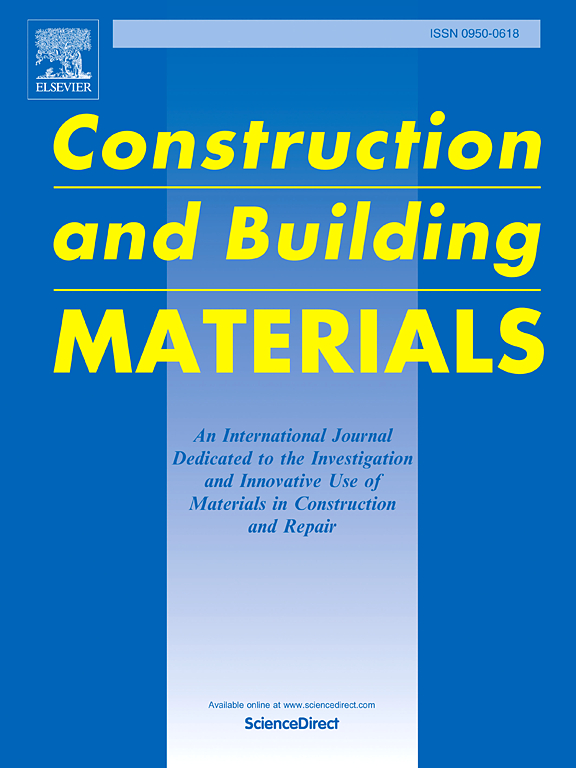混杂纤维增强混凝土对火灾的热与动力响应:实验与计算方法
IF 7.4
1区 工程技术
Q1 CONSTRUCTION & BUILDING TECHNOLOGY
引用次数: 0
摘要
火灾和爆炸事件对基础设施构成重大威胁,导致毁灭性的人员和经济损失。为了解决这个问题,混合纤维增强混凝土(HFRC)因其优异的抗压强度(CS)和耐久性而成为一种有前途的材料。然而,它在极端高温下的性能仍然是一个关键问题。本研究对HFRC的耐火性能进行了深入的研究,探讨了HFRC在高温和动载条件下的耐火性能。实验测试在含钢纤维、合成纤维、高效减水剂和粉煤灰的HFRC样品上进行,分别暴露于200°C、400°C、600°C和800°C的温度下,持续时间为30、60、90和120 min。结果揭示了有趣的趋势:动态抗压强度(fcd)和比能吸收(SEA)最初增加,在200℃达到峰值,然后在更高温度下下降,而应变率效应(ε)持续上升。在400°C时确定了最佳fcd阈值,合成纤维显著提高了动态性能,特别是在纤维含量为1.5 %时。为了进一步加深理解,本研究采用了尖端的机器学习技术,利用213个实验数据点开发了XGBoost模型。这些模型显示出显著的预测准确性,r值分别为0.998(训练)、0.920(验证)和0.899(测试)。全局敏感性分析强调温度和高应变率是影响最大的因素。通过将实验见解与先进的预测模型相结合,本研究提供了对极端条件下HFRC行为的全面理解,为设计弹性耐火基础设施铺平了道路。这项工作不仅弥补了关键的知识差距,而且为工程师和研究人员提供了可操作的工具,以提高高风险环境中的结构安全性。本文章由计算机程序翻译,如有差异,请以英文原文为准。
Thermal and dynamic response of hybrid fiber-reinforced concrete to fire exposure: Experimental and computational approaches
Fire and explosive events pose significant threats to infrastructure, leading to devastating human and economic losses. To address this, Hybrid Fiber-Reinforced Concrete (HFRC) has emerged as a promising material due to its exceptional compressive strength (CS) and durability. However, its performance under extreme heat remains a critical concern. This study delves into the fire resistance of HFRC, exploring how it withstands high temperatures and dynamic loading conditions. Experimental tests were conducted on HFRC samples, incorporating steel fibers, synthetic fibers, superplasticizer, and fly ash, exposed to temperatures of 200°C, 400°C, 600°C, and 800°C for durations of 30, 60, 90, and 120 min. The results reveal intriguing trends: dynamic compressive strength (fcd) and specific energy absorption (SEA) initially increase, peaking at 200°C, before declining at higher temperatures, while strain rate effects (ε) consistently rise. The optimal fcd threshold is identified at 400°C, with synthetic fibers significantly enhancing dynamic properties, particularly at a 1.5 % fiber content. To further advance understanding, this study employs cutting-edge machine learning techniques, developing XGBoost models using 213 experimental data points. These models demonstrate remarkable predictive accuracy, with R-values of 0.998 (training), 0.920 (validation), and 0.899 (testing). Global Sensitivity Analysis underscores temperature and high strain rate as the most influential factors. By combining experimental insights with advanced predictive modelling, this research offers a comprehensive understanding of HFRC's behaviour under extreme conditions, paving the way for designing resilient, fire-resistant infrastructure. This work not only bridges critical knowledge gaps but also provides actionable tools for engineers and researchers striving to enhance structural safety in high-risk environments.
求助全文
通过发布文献求助,成功后即可免费获取论文全文。
去求助
来源期刊

Construction and Building Materials
工程技术-材料科学:综合
CiteScore
13.80
自引率
21.60%
发文量
3632
审稿时长
82 days
期刊介绍:
Construction and Building Materials offers an international platform for sharing innovative and original research and development in the realm of construction and building materials, along with their practical applications in new projects and repair practices. The journal publishes a diverse array of pioneering research and application papers, detailing laboratory investigations and, to a limited extent, numerical analyses or reports on full-scale projects. Multi-part papers are discouraged.
Additionally, Construction and Building Materials features comprehensive case studies and insightful review articles that contribute to new insights in the field. Our focus is on papers related to construction materials, excluding those on structural engineering, geotechnics, and unbound highway layers. Covered materials and technologies encompass cement, concrete reinforcement, bricks and mortars, additives, corrosion technology, ceramics, timber, steel, polymers, glass fibers, recycled materials, bamboo, rammed earth, non-conventional building materials, bituminous materials, and applications in railway materials.
 求助内容:
求助内容: 应助结果提醒方式:
应助结果提醒方式:


